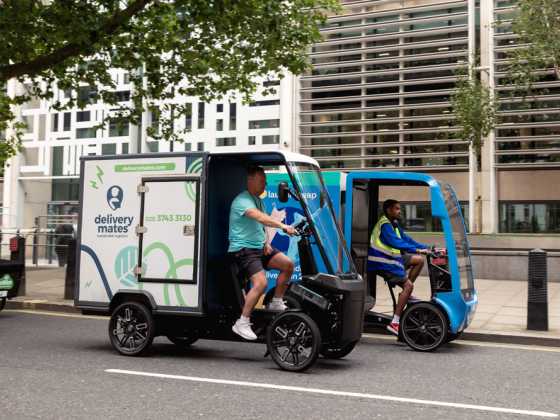Cutting through the mist of winter driving
While trying to maintain customer expectations is pivotal, no driver should feel pressured into driving in bad weather conditions. To help see motorists safely through the winter weather, the Institute of Advanced Motorists’ Lesley Upham shares her top tips.
 Driving in winter weather can be challenging, particularly for motorists who are forced to drive through a host of winter hazards. Fleet drivers will often stay on the road whatever the weather brings – but should these drivers really be travelling if weather conditions worsen?
Driving in winter weather can be challenging, particularly for motorists who are forced to drive through a host of winter hazards. Fleet drivers will often stay on the road whatever the weather brings – but should these drivers really be travelling if weather conditions worsen?
In 2014, 12,445 accidents took place on built up roads that were either flooded or wet in the dark – a 19 per cent increase since 2010. Other contributory factors to road accidents in 2014 included snow, sleet, rain or fog (causing 368 fatal or serious accidents) and slippery roads (causing 1,279 fatal or serious accidents).
Additionally, the number of people seriously injured as a result go a reported road traffic accident increased by five per cent to 22,807.
According to the key findings of the 2014 Reported Road Casualties in Great Britain Annual Report, a statistical model has indicated that had the weather throughout 2014 been closer to the long‑term average then there may have been around 43 fewer fatalities during the year.
When adjusted for the weather, the number of fatalities would have risen by one per cent (rather than four) from 2013 to 2014. Once an adjustment is made for the weather for all years back to 1991, the small rise in fatalities in 2014 is the first rise since 2003.
At the end of 2015, the Institute of Advanced Motorists (IAM) has launched its #wheelsinwinter campaign to support motorists in driving safely this winter.
Sarah Sillars, chief executive officer at the IAM, said: “It is clear from the statistics that people need to change their driving behaviour when faced with poor weather conditions and more hours of darkness.
“Winter driving needn’t be difficult, and with a few small changes driving in bad weather conditions can be made far safer and more enjoyable. We advise motorists to avoid travelling in severe weather conditions – could you delay that visit to the shops or walk to school instead? But if you do need to travel, prepare properly and read our advice to ensure you and your loved ones are safe.”
Lesley Upham’s top tips
Don’t forget to regularly check your vehicle’s oil, coolant and washer fluid/de-icer levels, which should all be at the correct concentration for winter. Once all checks have been made, look for any weather and traffic updates, which may affect your journey – this will help you make an informed decision about whether it is safe to travel before setting off.
On long journeys, the weather could well change en-route. If you have already started your journey and conditions worsen pull up at a service station to see if the weather subsides. Don’t carry on because you feel time-pressured to do so. In such circumstances, it’s a good idea to inform your customers about why you are getting delayed – this will help take time pressure off you and the customer, who may well be able to use their time more effectively.
You should also consider taking a break at a service station if you’re on the road for a long period of time in the dark. The onset of darkness during the winter months can lead to fatigue behind the wheel. If you can avoid driving at night do so, and try and stick to making journeys during the day when visibility is much clearer and when you’re more likely to stay alert.
If you drive at night on wet or icy roads, your visibility will be significantly reduced, especially when lights reflect off a wet road and you can’t see the road markings clearly. When approaching junctions, increase your stopping distance by as much as 10 times to give yourself more time to see what is going on around you and to ensure you have more time to get into the correct lane or stop safely.
Low sun is another winter hazard, even with a clean windscreen and windows. When you emerge from a side road onto a busy road, low sun may make it difficultfor you to see whether it is safe to join the nearby lane. Try and judge the speed of other vehicles before joining the lane and join when it is safe to do so. Be aware when the sun is behind you as other road users might not judge your speed of approach accurately or simply might not even see you – use dipped lights at these times.
Tailgating can be incredibly dangerous, particularly during the winter months – from strong winds to icy roads you are more likely to lose control of your vehicle. And be aware that snow can build up on top of trucks in large sheets – avoid following large vehicles too closely if there’s been a recent snowfall.
Always be prepared. Make sure the number of your breakdown service provider is in your phone and that you have a back-up charger to hand. Breakdowns are most likely to occur during this time of year, so be prepared for the worst. Ensure you have de-icing equipment, a warm jacket and some snacks with you incase you get grid locked in heavy snow.
High winds
Mark Lewis, IAM’s director of standards, has also supplied advice on driving in high winds. He warned drivers to, where possible, plan journeys beforehand and check for any travel disruptions that could cause an issue.
Avoid driving through country roads which are more likely to be exposed to fallen branches and debris.
Gusts of wind can unsettle vehicles – so grip your steering wheel firmly with both hands. This is particularly important when planning an overtake.
Remember to give vulnerable road users including, cyclists, motorcyclists and pedestrians more room than usual. They are more likely to be blown around by side winds – always keep a safe distance. As you approach a bend ensure you are able to stop on your own side of the road in the distance you can see to be clear – you never know what’s around the corner.
If large debris is obstructing the road ahead, be prepared to make a U-turn and use another route. Keep an eye out for gaps between trees, buildings or bridges over a river or railway – these are some of the places you are more likely to be exposed to side winds.
Ensure that you maintain enough room either side of your vehicle so you can account for it being blown sideways.
Mark said: “Driving in windy conditions can be quite challenging, so it’s important that you concentrate on the road at all times and take particular care when driving through narrow roads or over bridges. Also, keep an eye out for where you will suddenly go from a windy section of the road to a sheltered one – sudden loss of strong winds can be just as unbalancing, so be prepared.”
Post winter blues
Winter driving puts an increased strain on both you and your car, so it’s important to make sure that everything is in good order. A few simple checks can greatly reduce the chance of a breakdown, as well as potentially making your car easier and less stressful to drive in winter ice and snow.
Fixing something that’s relatively inexpensive now, after all, might avoid a much more costly failure in the colder conditions – or prevent you from having to pay a costly recovery fee after becoming stranded somewhere.
With the weather warning from the Met Office continuing past the New Year and into the early months of 2016, road journeys are due to become more difficult and treacherous, particularly in the event of snowfall.
The delayed winter this year may mean that many drivers forget to ‘winter proof’ their cars, which may incur unwelcome, avoidable and expensive repairs.
Keeping the battery charged (car batteries work harder during the winter months), checking tyres regularly (safe tread is a necessity), brake testing (roads are far more slippery in winter months), clear windscreens (winter weather can obscure a driver’s view), and keeping an emergency kit (in case of a break-down) are all advisable tips to be aware of.






